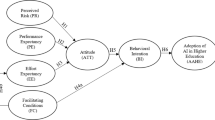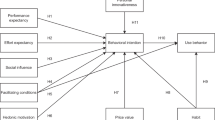Abstract
This study aims to determine the Information and Communication Technology (ICT) tools utilized by university faculties in East Africa and China, and to explore the connections allying instructors' perceptions over technology use and technology applications. A cross-sectional survey design questionnaire gathering information on the use of and attitudes towards technology applications was sent to five East African universities, and six Chinese universities. Respectively, data from 305 and 268 faculty members were collected, and analyzed using Technology Acceptance Modeling (TAM) combined with empirical and computational statistics. The results analysis found that only 19% of East African faculties taught part or all of an online course as compared to 69% of Chinese faculties. East Africa faculties use western social media much more than China faculties. However, China faculties use local social media more often. Findings from the relationships' path analysis reveal that for East Africa, System is the only variable that establishes a significant relationship with Actual technology Use. Ease of Use is closely related to Perceived Value, while Perceived Value is significantly related to Attitude towards technology. For China, System is the only variable that establishes a significant relationship with the Actual technology Use. Moreover, we find a wider relationship allying System Use and Actual technology tools Use for Chinese faculties indicating that they have more ICT access opportunities, thus their experience of using technology tools is more than that of East African faculties.





Similar content being viewed by others
Availability of data and materials
The datasets used and/or analyses during the current study are available from the corresponding author on reasonable request.
References
Ajjan, H., & Hartshorne, R. (2008). Investigating faculty decisions to adopt Web 2.0 technologies: Theory and empirical tests. The Internet and Higher Education, 11(2), 71–80.
Alenezi, A. (2012). Faculty members’ perception of e-learning in higher education in the Kingdom of Saudi Arabia(KSA).
Allen, I. E., & Seaman, J. (2013). Changing course: Ten years of tracking online education in the United States: ERIC.
Almerich, G., Orellana, N., Suarez-Rodriguez, J., & Diaz-Garcia, I. (2016). Academicians’ information and communication technology competences: A structural approach. Computers & Education, 100, 110–125. https://doi.org/10.1016/j.compedu.2016.05.002
Alshahri, M. (2015). A comparison of Saudi and United States faculty use of information and communication technology tools: Montana State University.
Archer, K., Savage, R., Sanghera-Sidhu, S., Wood, E., Gottardo, A., & Chen, V. (2014). Examining the effectiveness of technology use in classrooms: A tertiary meta-analysis. Computers & Education, 78, 140–149. https://doi.org/10.1016/j.compedu.2014.06.001
Awidi, I. T., & Cooper, M. (2015). Using management procedure gaps to enhance e-learning implementation in Africa. Computers & Education, 90, 64–79. https://doi.org/10.1016/j.compedu.2015.08.003
Bharuthram, S., & Kies, C. (2013). Introducing e-learning in a South African Higher Education Institution: Challenges arising from an intervention and possible responses. British Journal of Educational Technology, 44(3), 410–420.
Browne, M. W., & Cudeck, R. (1993). Alternative ways of assessing model fit. Sage Focus Editions, 154, 136–136.
Cleaver, S. (2014). Technology in the classroom: helpful or harmful?
Davis, F. D. (1989). Perceived usefulness, perceived ease of use, and user acceptance of information technology. MIS Quarterly, 13, 319–340.
Denker, K. J., Manning, J., Heuett, K. B., & Summers, M. E. (2018). Twitter in the classroom: Modeling online communication attitudes and student motivations to connect. Computers in Human Behavior, 79, 1–8.
DeVellis, R. F., Lewis, M. A., & Sterba, K. R. (2003). Interpersonal emotional processes in adjustment to chronic illness. In J. Suls & K. A. Wallston (Eds.), Social psychological foundations of health and illness (pp. 256–287). Blackwell Publishing.
EASTECO. (2017). Retrieved May 2017, from https://easteco.org.East African Science and Technology Commission.
Ferraro, S. (2018). Is information and communication technology satisfying educational needs at school? Computers & Education, 122, 194–204. https://doi.org/10.1016/j.compedu.2018.04.002
Fishbein, M., & Ajzen, I. (1975). Belief, attitude, intention and behavior: An introduction to theory and research.
Jöreskog, K., & Sörbom, D. (2005). LISREL 87 for Windows: User’s Reference Guide. Scientific Software International Inc.
Kay, R., Benzimra, D., & Li, J. (2017). Exploring factors that influence technology-based distractions in bring your own device classrooms. Journal of Educational Computing Research, 55(7), 974–995.
Li, J. (2017). Ideologies, strategies and higher education development: A comparison of China’s university partnerships with the Soviet Union and Africa over space and time. Comparative Education, 53(2), 245–264.
MacCallum, R., Lee, T., & Browne, M. W. (2010). The issue of isopower in power analysis for tests of structural equation models. Structural Equation Modeling, 17(1), 23–41.
Matikiti, R., Mpinganjira, M., & Roberts-Lombard, M. (2018). Application of the Technology Acceptance Model and the Technology-Organisation-Environment Model to examine social media marketing use in the South African tourism industry. South African Journal of Information Management, 20(1), 1–12. https://doi.org/10.4102/sajim.v20i1.790
Mills, G. E., & Gay, L. R. (2016). Educational research: Competencies for analysis and applications. Pearson.
Moran, M., Seaman, J., & Tinti-Kane, H. (2011). Teaching, learning, and sharing: How Today's Higher Education Faculty Use Social Media. Babson Survey Research Group.
Munyengabe, S., Mukamusoni, D., Harindintwari, J., & Ndeze, J. C. (2019). Information Communication Technology as catalyst for pedagogical changes to generate a smart manpower requirement in developing countries. Eurasia Journal of Mathematics, Science and Technology Education, 15(10), 1753. https://doi.org/10.29333/ejmste/109041
Niyigena, J.-P., Jiang, Q., Hasan, A. T., Ziou, D., Chen, H., & Wang, P. (2018). ICT usage and attitudes among EAC undergraduate students: A case study. Ieee Access, 6(1), 42661–42674. https://doi.org/10.1109/ACCESS.2018.2854925
Nord, J. H., Paliszkiewicz, J., & Koohang, A. (2014). Using social technologies for competitive advantage: impact on organizations and higher education. Journal of Computer Information Systems, 55(1), 92–104. https://doi.org/10.1080/08874417.2014.11645744
Oleszkiewicz, A., Karwowski, M., Pisanski, K., Sorokowski, P., Sobrado, B., & Sorokowska, A. (2017). Who uses emoticons? Data from 86,702 Facebook users. Personality and Individual Differences, 119, 289–295.
Omar, M. S., Njeru, A., & Yi, S. (2017). The Influence of Twitter on Education Policy Making.
Payette, D. L., & Verreault, D. (2007). Teaching methods and technologies: Aggregated faculty analysis, conclusions and recommendations phase IV. Journal of College Teaching & Learning, 4(6), 43–60.
Protalinski, E. (2014). Facebook passes 1.23 billion monthly active users, 945 million mobile users, and 757 million daily users. The Next Web, 29.
Rawlins, P., & Kehrwald, B. (2014). Integrating educational technologies into teacher education: A case study. Innovations in Education and Teaching International, 51(2), 207–217.
Robillard, J. M., Cleland, I., Hoey, J., & Nugent, C. (2018). Ethical adoption: A new imperative in the development of technology for dementia. Alzheimer’s & Dementia : the Journal of the Alzheimer’s Association. https://doi.org/10.1016/j.jalz.2018.04.012
Rogers, E. M., Medina, U. E., Rivera, M. A., & Wiley, C. J. (2005). Complex adaptive systems and the diffusion of innovations. The Innovation Journal: the Public Sector Innovation Journal, 10(3), 1–26.
Ronghuai, H., & Xiaolin, L., et al. (2017). Investigation of Key School-related Indicators Influencing ICT in K-12 Education. In E. Popescu (Ed.), Innovations in smart learning (pp. 75–80). Springer.
Seaman, J., & Tinti-Kane, H. (2013). Social media for teaching and learning. Pearson.
Smith, M. (2014). Strategies That Work–One school technology learder’s winning strategies for staff development in technology integration. Retrieved May 2017, 2017, from http://www.scholastic.com/browse/article.jsp?id=60
Starr, L. (2012). Encouraging teacher technology use. Education World.
Tabata, L. N., & Johnsrud, L. K. (2008). The impact of faculty attitudes toward technology, distance education, and innovation. Research in Higher Education, 49(7), 625.
Tang, Y. (2015). Strategies That Work. One school technology learder's winning strategies for staff development in technology integration. Paper presented at the Proceedings of the 2015 International Conference on Management Science and Management Innovation
Tang, Y., & Hew, K. F. (2017). Using Twitter for education: Beneficial or simply a waste of time? Computers & Education, 106, 97–118. https://doi.org/10.1016/j.compedu.2016.12.004
Tarus, J. K., Gichoya, D., & Muumbo, A. (2015). Challenges of Implementing E-Learning in Kenya: A Case of Kenyan Public Universities. International Review of Research in Open and Distance Learning, 16(1), 1–10. https://doi.org/10.19173/irrodl.v16i1.1816
Unesco. (2015). Report. . Retrieved May from http://en.unesco.org/gem-report/report//education-all--achievements-and-challenges (Vol. 2015 SRC - GoogleScholar)
Usluel, Y. K., & Mazman, S. G. (2009). Adoption of Web 2.0 tools in distance education. Journal of Human Sciences, 6(2), 89–98.
Vajargah, K. F., Jahani, S., & Azadmanesh, N. (2010). Application of ICTS in teaching and learning at University level: The case of Shahid Beheshti University. Turkish Online Journal of Educational Technology, 9(2), 33–39.
Veletsianos, G., & Kimmons, R. (2016). Scholars in an increasingly open and digital world: How do education professors and students use Twitter? Internet and Higher Education, 30, 1–10.
Wang, J., Abdullah, A. S., Ma, Z., Fu, H., Huang, K., Yu, H., . . . Xiao, J. (2017). Building capacity for information and communication technology use in global health research and training in China: A qualitative study among Chinese health sciences faculty members. Health Research Policy and Systems, 15(1), 59
Wanstreet, C. E. (2006). Interaction in online learning environments: A review of the literature. Quarterly Review of Distance Education, 7(4), 399.
Ward, M. E., Peters, G., & Shelley, K. (2010). Student and faculty perceptions of the quality of online learning experiences. The International Review of Research in Open and Distributed Learning, 11(3), 57–77.
Wickramanayake, L., & Jika, S. M. (2018). Social media use by undergraduate students of education in Nigeria: A survey. Electronic Library, 36(1), 21–37.
Yilmaz, F. G. K., Yilmaz, R., Ozturk, H. T., Sezer, B., & Karademir, T. (2015). Cyberloafing as a barrier to the successful integration of information and communication technologies into teaching and learning environments. Computers in Human Behavior, 45, 290–298.
Zhang, D., & Nunamaker, J. F. (2003). Powering e-learning in the new millennium: An overview of e-learning and enabling technology. Information Systems Frontiers, 5(2), 207–218.
Zhang, S., Liu, Q., & Wang, Q. (2017). A study of peer coaching in Academicians’ online professional learning communities. Universal Access in the Information Society, 16(2), 337–347. https://doi.org/10.1007/s10209-016-0461-4
Funding
Not applicable.
Author information
Authors and Affiliations
Contributions
All authors contributed equally in conceptualization of the paper, the interpretation of the results, the development of the manuscript and the proofreading before the final submission.
Corresponding author
Ethics declarations
Competing interests
The authors declare that there is no conflict of interests regarding to this research paper.
Additional information
Publisher's Note
Springer Nature remains neutral with regard to jurisdictional claims in published maps and institutional affiliations.
Rights and permissions
About this article
Cite this article
Munyengabe, S., Niyigena, J.P., Mukamusoni, D. et al. East Africa and China faculty use of information and communication technology tools: a descriptive and comparative analysis. Education Tech Research Dev 69, 1773–1797 (2021). https://doi.org/10.1007/s11423-021-10012-9
Accepted:
Published:
Issue Date:
DOI: https://doi.org/10.1007/s11423-021-10012-9




